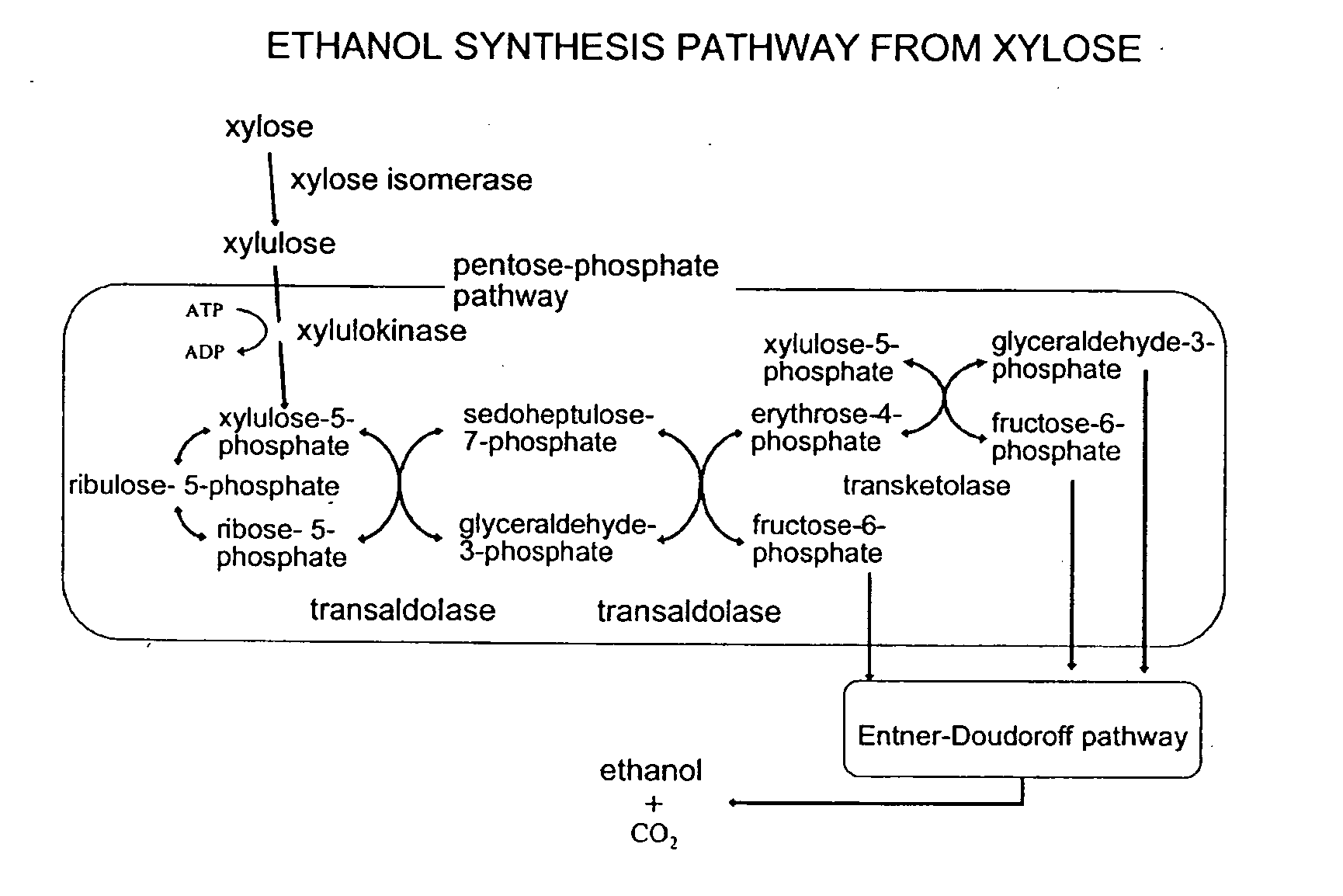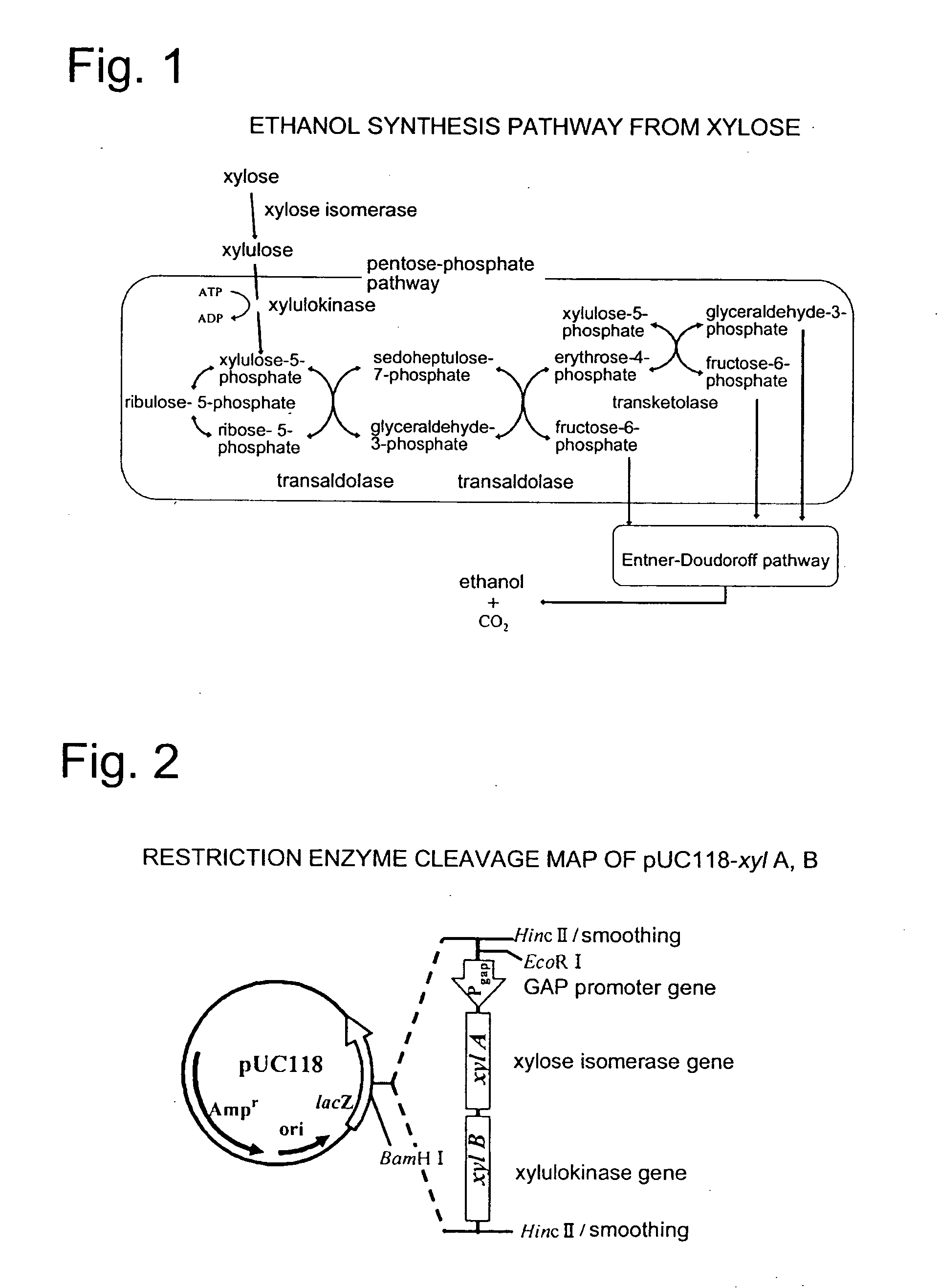Pentose-fermentative transformed Zymobacter microorganisms
a technology of zymobacter and pentose, which is applied in the field of pentosefermentative transformed zymobacter microorganisms, can solve the problems of inability to produce ethanol from xylose, and achieve the effect of widening the range of fermentable sugars and facilitating the adaptation to fermentation feedstocks
- Summary
- Abstract
- Description
- Claims
- Application Information
AI Technical Summary
Benefits of technology
Problems solved by technology
Method used
Image
Examples
example 1
Construction of a Recombinant Plasmid DNA Containing E. coli-Derived Xylose Isomerase and Xylulokinase Genes
[0034]Zymobacter palmae is unable to ferment xylose. As the causes therefor, deficiency or low activity level in said bacterium of xylose isomerase which is an enzyme for converting xylose to xylulose; xylulokinase which is an enzyme catalyzing phosphatizing reaction of xylulose; and aldosereductase and transketolase which are key enzymes for leading the converted xylulose phosphate to biosynthesis of ethanol via pentose phosphate pathway. Therefore, it becomes possible to impart ethanol producing ability from xylose to the bacterium, by introducing thereinto these enzyme genes and allowing their expression (FIG. 1).
[0035] Accordingly, we cloned these enzyme genes from E. coli genome DNA by means of PCR. Furthermore, by expressing the introduced four kinds of enzyme genes in Zymobacter palmae cells, we utilized a promoter gene (GAP promoter) which controls expression of glyc...
example 2
Construction of a Recombinant Plasmid DNA Containing E. coli-Derived Transaldolase and Transketolase Genes
[0039] On E. coli genome DNA, transaldolase gene and transketolase gene do not form an operon but are conformed at mutually distant positions. Therefore, transaldolase and transketolase were individually cloned and linked to come under the control of Zymomonas mobilis-derived GAP promoter. For this purpose, the following four kinds of PCR primers were designed, based on known Zymomonas mobilis-derived glyceraldehyde-3-phosphate dehydrogenase gene sequence and known E. coli-derived transaldolase gene (Nucleic Acids Res., Vol. 20, 3305-3308, 1992):
ZGT1:5′-CGCGGATCCGTTCGATCAACAACCGAATCCTATC-3′,ZGT2:5′-CTTAATAAGTTAGGAGAATAAACATGACGGACAAATTGACCTCCCTTCGT-3′ZGT3:5′-ACGAAGGGAGGTCAATTTGTCCGTCATGTTTATTCTCCTAACTTATTAAG-3′ETA4:5′-CATTTTGACTACCAGATCTAGATTACAGCAGATCGCCGATCATTTTTTCC-3′.
[0040] As the first PCR, using a genome DNA prepared from Zymomonas mobilis as the template, an about 300 ...
example 3
Construction of Recombinant Plasmid DNA Containing Xylose-Fermentative Gene
[0046] For introducing and expressing four kinds of xylose metabolic enzyme genes in Zymobacter palmae, these genes were inserted into a broad host range plasmid vector to synthesize a recombinant plasmid.
[0047] An about 3.4 kbpDNA fragment containing GAP promoter gene, xylose isomerase gene and xylulokinase gene was prepared by cleaving recombinant plasmid pUC118-xylA, B with EcoRI restriction enzyme and BamHI restriction enzyme. Also an about 3.3 kbpDNA fragment containing GAP promoter gene, transaldolase gene and transketolase gene was prepared by cleaving recombinant plasmid pUC118-tal+tkt with BamHI restriction enzyme and XhoI restriction enzyme. These two fragments were mixed with an about 11.6 kbpDNA fragment which was prepared by cleaving a broad host range vector plasmid pMFY 31 (Agric. Biol. Chem. Vol. 49 (9), 2719-2724, 1985) with EcoRI restriction enzyme and SalI restriction enzyme, and ligated ...
PUM
 Login to View More
Login to View More Abstract
Description
Claims
Application Information
 Login to View More
Login to View More - R&D
- Intellectual Property
- Life Sciences
- Materials
- Tech Scout
- Unparalleled Data Quality
- Higher Quality Content
- 60% Fewer Hallucinations
Browse by: Latest US Patents, China's latest patents, Technical Efficacy Thesaurus, Application Domain, Technology Topic, Popular Technical Reports.
© 2025 PatSnap. All rights reserved.Legal|Privacy policy|Modern Slavery Act Transparency Statement|Sitemap|About US| Contact US: help@patsnap.com



